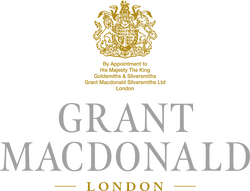
"The wonderful thing about these commissions is incorporating key symbols and elements, that are important to the wearer, into the design, so each one is unique. I have always worked on the premise that the more effort you put in at the design stage the better the work will come out in the end. The design process can involve a lot of painstaking research as the result has to be absolutely perfect." Grant Macdonald
-
Did you know that the City of London is under protection? Dragons watch over the main roads into the ancient City, painted silver with details picked out in red, standing on their rear legs, lifting a shield that bears the City of London’s coat of arms.
The designs for these draconic guardians are based on two large dragon sculptures which were originally mounted about the entrance of the Coal Exchange, since demolished. The two original dragons were moved to stone plinths, resting at the western boundary of the City - you’ll find them by the Temple Gardens on Victoria Embankment. The Corporation of London’s committee of the streets selected these statues as a model for the city’s boundary markers, with half-size replicas created and erected at the main entrances to the City of London. There are thirteen of them now.
Why dragons? It comes down to the heraldic symbolism of this magnificent beast - a dragon, seen in a coat of arms, stands for courage, power and the treasure that Western dragons are said to hoard. Positioned at the boundaries of the City of London, these dragons symbolise power and wealth, guarded keenly.
Grant Macdonald London has a long-established association with the City of London. Word of mouth has played a huge part in the City celebrating our craftsmen’s ability to include personal touches in pieces such as Sheriff’s badges, brooches, lecterns and loving cups - Livery Companies, in particular the Barbers’ Company, have given our workshop plenty of opportunities to develop a talent for heraldry involving symbols much like the City’s dragons.
When it comes to designing a Sheriff’s badge, meaning is crucial. The process involves a conversation between the prospective Sheriff and the designer, where they discuss everything they might wish to incorporate into the piece: work, hobbies, children and other interests. The centre of the badge must be the client’s coat of arms, which will be hand-carved or picked out in vitreous enamels. The surrounding framework can contain other personal references - the duty of the badge is to tell the story of the wearer, and through British craftsmanship techniques we can create a biographical ‘shorthand’ in gold or silver.
-
Learn more about Grant Macdonald London’s relationship with The City of London and discover our proud history of crafting ceremonial maces, Sheriff’s badges, chains of office, brooches, lecterns, candlesticks and loving cups.
